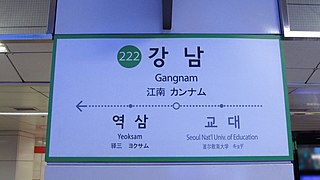
Gangnam is a station on Line 2 of the Seoul Metropolitan Subway. The station is located within the Greater Gangnam Area between the Gangnam and Seocho Districts of Seoul, South Korea. The station is the busiest station on the Seoul Metropolitan Subway, serving over 70,000 daily passengers on average.

Bangbae station, also known as Baekseok Arts University (Korean: 백석예술대) station, is a subway station on the Line 2 of the Seoul Metropolitan Subway. The station is located in the Bangbae neighborhood of Seocho District, Seoul. The tomb of Grand Prince Hyoryeong (Korean: 효령대군), the second son of King Taejong—the third monarch of the Joseon Dynasty—is located to the northeast.

Samseong Station is a station on Seoul Subway Line 2. It serves the eastern area of Teheranno. Some of the more famous buildings near the station include World Trade Center Seoul, COEX Mall, Korea Electric Power (KEPCO) headquarters, Korea Air City Terminal, and Gangnam main police and fire stations. Due to security concerns, the station was closed during the G20 summit and the 2012 Nuclear Security Summit, as this station is directly connected with COEX.

Yeoksam Station is a station on Line 2 of the Seoul Subway. It is located in Yeoksam-dong, Gangnam-gu, Seoul.

Yangjae Station is a station on the Seoul Subway Line 3 and Shinbundang Line. It was the southern terminus of Line 3 until October 30, 1993, when the line was extended to Suseo station, and it became a transfer station with the Shinbundang Line on October 28, 2011. It is located in Yangjae-dong, Seocho and Gangnam District, Seoul.

Guui Station (Korean: 구의역) is a station on the Seoul Subway Line 2. Because of its proximity to the Gwangjin District Office, it is also known as Gwangjin-gu Office Station.

Hyehwa Station (Korean: 혜화역) is a station on the Seoul Subway Line 4 in Jongno District, Seoul. It is located in the center of the area commonly known as Daehangno, and much of the ridership of this station comes from the nightlife scene. The Seoul National University Yongon campus, housing its Hospital and School of Medicine, is located to the southwest.
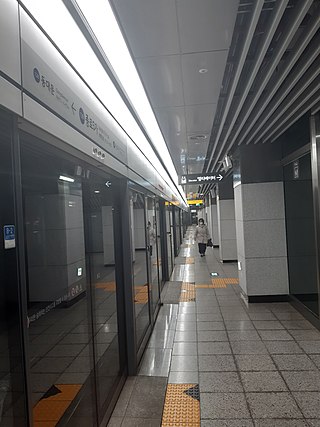
Jongno 5(o)-ga Station is a station on the Seoul Subway Line 1. It is located underneath Jongno, a major street in downtown Seoul.
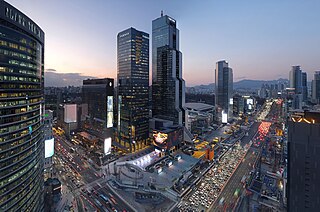
Gangnam District is one of the 25 districts of Seoul, South Korea. The term Gangnam translates to "South of the [Han] River". Gangnam District is the third largest district in Seoul, with an area of 39.5 km2 (15.3 sq mi). As of the 2024 census, Gangnam District had a population of 556,570. There is a high concentration of wealth in the district, with prices for an apartment as of 2024 more than double those in the rest of Seoul. Gangnam District is part of Gangnam School District Eight, along with the Seocho District. This district shares half of Gangnam-daero Gangnam Station area with Seocho District, which is one of the most crowded places in South Korea.

Seocho District is one of the 25 local government districts which make up the city of Seoul, South Korea. Seocho is a part of the Gangnam region, along with the Gangnam district of Seoul. Seocho District ranks as one of the richest neighborhoods in South Korea and among the most expensive areas in Seoul with an average sales price of 47.75 million South Korean won per 3.3 square meters. Many of the wealthiest residents are concentrated in the three Gangnam districts including Seocho, known as Gangnam School District Eight.
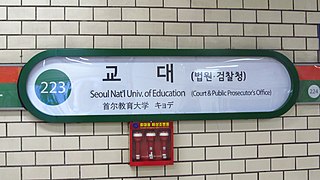
Seoul Nat'l Univ. of Education Station is a station in the Seocho District of Seoul, on Seoul Subway Line 2 and Line 3. It is usually noted on station signs and on-board announcements that the station serves Court & Prosecutors' Office.

Buramsan Station (Korean: 불암산역) is a station on Line 4 of the Seoul Metropolitan Subway network. It was the northern terminus of Line 4, until 19 March 2022, when the line was extended to Jinjeop. It is an elevated station. The name of the subway station comes from its local name. Regional names refer to the pass that travelers carried over because of wild animals.

Seocho-dong is a dong, or neighborhood of the greater Gangnam area Seocho-gu district of the South Korean city of Seoul. Seocho-dong is divided into 4 different dong which are Seocho 1-dong, 2-dong, 3-dong and 4-dong. The main street is Teheranno. There is Gangnam Station in Seocho-dong, which is one of the biggest stations in Korea.
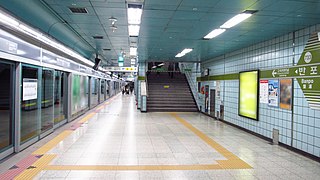
Banpo Station is a metro station on Seoul Subway Line 7 located in Jamwon-dong, Seocho District, Seoul. Despite its name, the station is not located in Banpo-dong, but instead in Jamwon. It has 6 entrances that they are all right side entrance and they have screen doors right before entering the train. It takes 4~8 minutes between 2 trains and next stations are Nonhyeon and Seoul Express Bus Terminal. It is only 500m long between Banpo station and two other Stations next to it. The station number is 733.

Sungshin Women's University Station is a station on the Line 4 of the Seoul Subway and Ui LRT in Seoul, South Korea. As its name indicates, it serves the nearby Sungshin Women's University.

Chang-dong Station is a station on Seoul Subway Line 1 and Line 4. It is located in Chang-dong, Dobong District, Seoul, South Korea. A shopping center was planned for this site, but the empty lot has never been developed due to the bankruptcy of the contractor behind said project. The station is, however, home to a cluster of pojangmacha stalls.

Onsu Station is a station on the Seoul Subway Line 1. It was the former western terminus of Seoul Subway Line 7. A westward extension of Line 7 was completed in October 2012. It is near the border of Seoul and Bucheon.

Moran Station serves as the southern terminal of Seoul Subway Line 8 and is also a stop on the Suin–Bundang Line. The Moran Market is held near the station during the 4th and 9th days of the month.

Gil-dong Station is a subway station on Seoul Subway Line 5 in Gangdong District, Seoul. There is a connecting track from this station to Dunchon-dong Station on the Macheonji Line of Line 5, but it is a return train track for the arrival and departure of the Godeok Vehicle Business Office and has nothing to do with passenger operations.
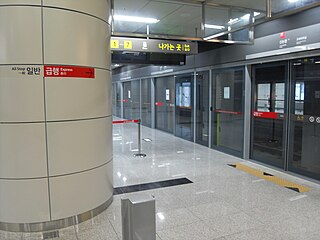
Sinnonhyeon Station is a railway station on Line 9 and the Shinbundang Line of the Seoul Metropolitan Subway, located by the Kyobo Tower sageori in Seocho District and Nonhyeon-dong, Gangnam District, Seoul. It was the southern terminus of Line 9 from 2009 to March 2015, when the line was extended to Sports Complex station. Gangnam Station and Nonhyeon Station are near here. It became a transfer station to the Shinbundang Line on May 28, 2022.





















